HARDEN UP!
By Sam Mossman
Polyethylene braid lines have resulted in big advances in rod and reel technology to handle the increased pressure these lines can apply. Sam Mossman explains how to up-spec lure hardware to cope with the strain.
Re-armouring the popper with inline single hooks allowed this king to be unhooked with minimal damage.
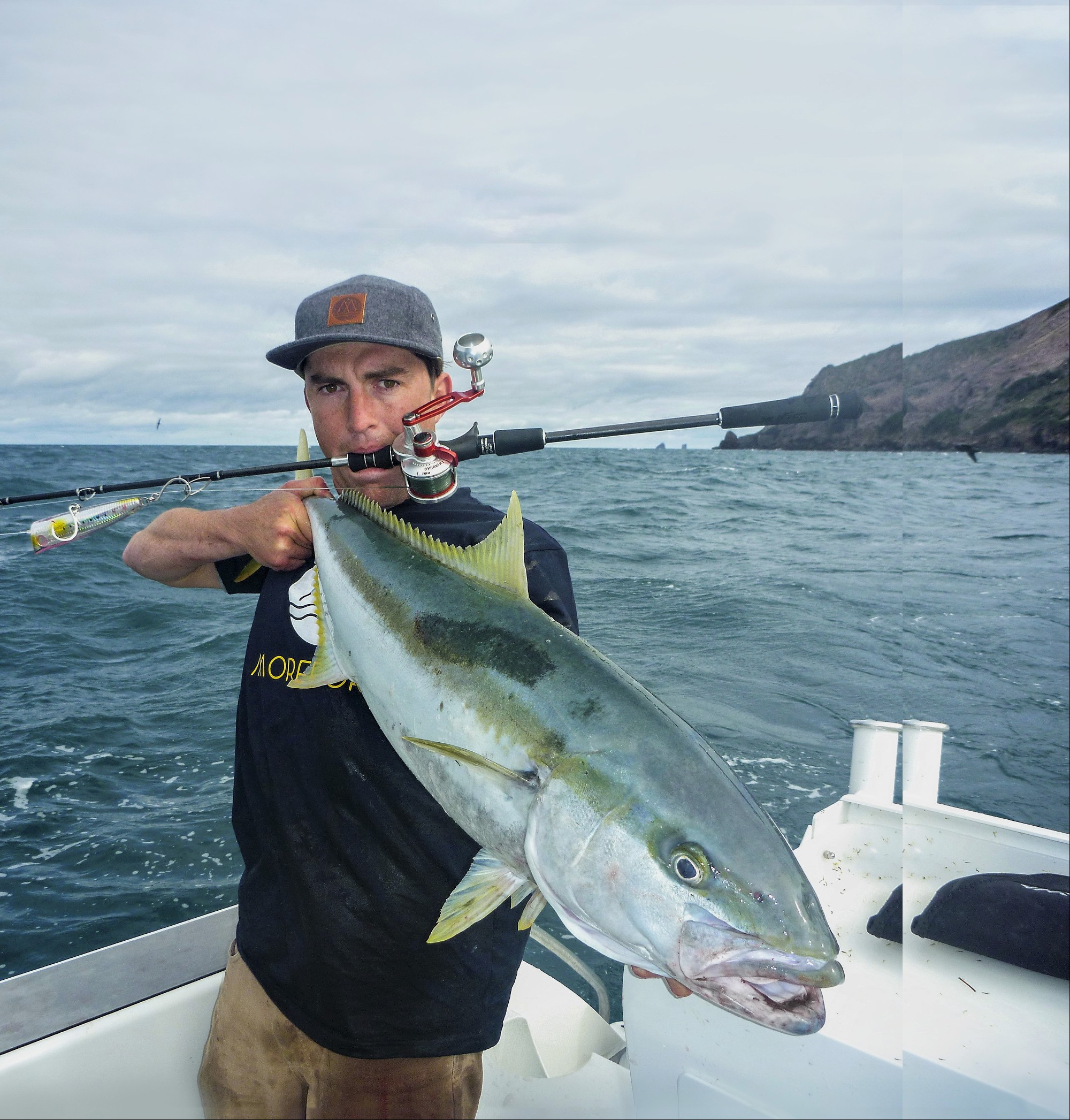
There have been huge changes in fishing tackle in recent decades. The latest wave was kicked off by the arrival of PE (Polyethylene) braided lines back in 1993. PE lines have supplanted nylon monofilament in many fishing disciplines with their high strength (per diameter) and very low stretch characteristics providing some significant advantages.
One aspect is that the greatly reduced diameter (for a given strength) of PE lines means spool capacity is no longer such a limiting issue, encouraging the use of smaller, lighter reels for tasks which they had not been designed.
This, in turn, kicked off a revolution in tackle design and manufacture to produce refined equipment that could cope with the pressures of using these thin but very strong lines.
Nowadays, large powerful fish like kingfish, tuna, and even marlin are regularly targeted – and caught – with eggbeaters and smaller troll/jig reels that have been greatly strengthened for use with braid lines. Rods, likewise, went through a rapid up-spec and the development of nano resins and high-compression carbon has resulted in many of today’s light, but near bullet-proof sticks. Assuming proper rigging and knotting techniques (such as splicing and the FG/PR suite of knots) are used, the terminal tackle (especially lures), can sometimes be the weakest link in modern rigs.
The principles of toughening up terminal tackle to cope with the pressures exerted by modern braid lines apply, by degrees, all the way from the heavy casting and trolling gear used on big fish, down to tiny lures and light rod and reel combos used on snapper, kahawai, skipjack and the like. The ratio of tackle size and strength to fish size and power is similar in each case, but the strain transferred to the terminal tackle is much greater with braid lines as there is little of the pressureabsorbing stretch provided by nylon monofilament.
Buy right
When shopping for blue water lures like bibbed or bib-less minnows, stickbaits or poppers, look for through-body wire construction. This means that all the wire eyelets that make up the towing point and hook attachments are strongly interconnected inside the lure body so the eyelets cannot pull out of the body under duress. Then, even if the lure is destroyed, you can still save the fish.
Body material, too, is important. Tough timber bodies, such as the abachi wood Rapala used in their classic Countdown Magnum (CD) range, were the way to go, but with the advent of modern superplastics and injection-moulding techniques this situation is reversed, with a well-made plastic bodied lure out-lasting a wooden one these days.
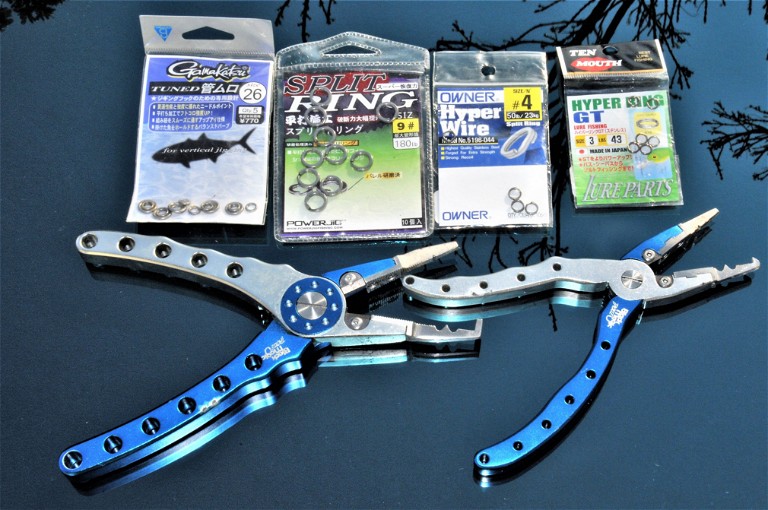
Split ring pliers are needed to install strong, high-quality split rings.
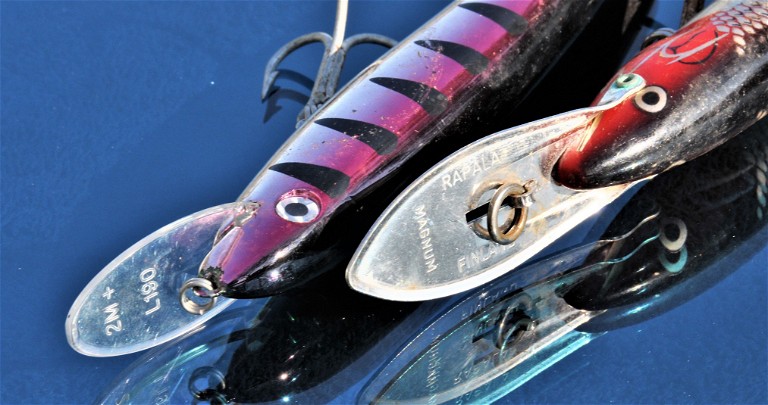
Some lures (Halco and Rapala are shown) incorporate an extra nose ring to allow a free-swimming movement.
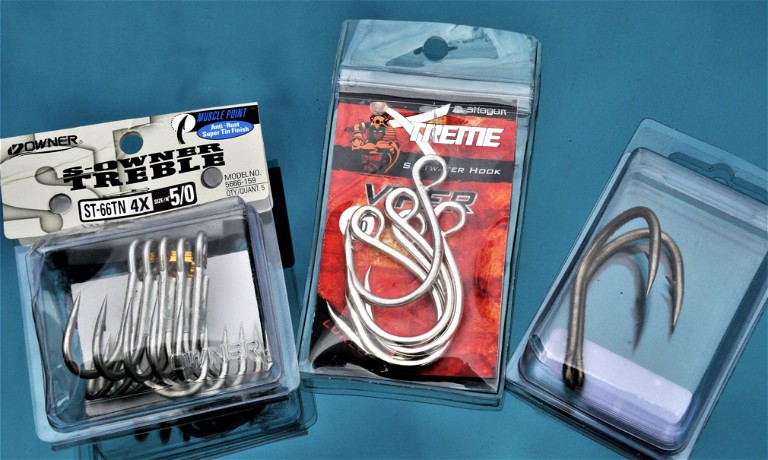
Hook upgrades can include super-strong trebles, inline singles or double ‘claw’ hooks.
Running rings around them
The main use for spilt rings is to attach the hook or hooks to the lure. With very few exceptions, the hooks and split rings supplied standard on minnow lures are not up to bluewater use with heavy braid on powerful sportfish and often need to be upgraded. This is a high-pressure point, especially when there are two hooks – often trebles – attached to the lure. Huge pressure can be applied when a fish is hooked in the mouth then fouls the second hook in the side when its body is bent for the next stroke of its tail. It can then apply all its powerful swimming muscles against the split rings and hooks. I have seen even kahawai uncoil strong-looking split rings on medium-sized poppers this way, as well as larger game fish.
Be sure to buy the highestquality split rings you can when you toughen up the hardware on your lures. You cannot tell how strong a split ring is just by looking at it; some quite thick wire ones can be made of very soft metal. Some of the best products include Owner Hyper/Ultra Wire, Tsunami, Decoy and Ten Mouth. Because these are very strong, you will need a quality set of split-ring pliers to install them.
Be sure to use the correct size of split ring for the hook and the lure. Over-sized split rings can bind up in the eye of the lure and/or the hook which then sits out of alignment so the lure doesn’t swim properly, but if the split rings are too small they may not fit over the eye of the hook easily and can be over-stretched and damaged while rigging.
By hook or by crook
Anglers used to be able to get a fair idea of the strength of a hook by the thickness of the wire it was made from. Over-strength hooks were indicated by ‘2x’, ‘3x’, or whatever. A 2x hook is made from wire as thick as usually used to make the next size of hook up, and so on. Another sure sign of a strong hook was a ‘flatted shank’, also called a ‘forged’ hook. By forging the hook on the side, it becomes thicker through the other plane and resists being bent open. However, wire thickness and flatted shanks are not necessarily the signs of strong hooks anymore – these signs can be ‘forged’ in the other sense of the word, too.
The plus side is that the latest good quality ‘name’ hooks can be brilliant. With exceptional strength coupled with relatively thin wire, micro-barbs, and out-of-the-box sticky-sharpness, they are much easier to set into a fish than the old pencil-thick hooks we had to use to get sufficient strength to cope with large fish. It is no surprise that many of the best of these hooks come from Japan.
Lures may come fitted with one, two or even three hooks, a mix of types, or even no hooks at all on some top-of the-line lures (as the manufacturers know that their tackle-nut customers are going to customise the hardware anyway).
Some lures swim better with treble hooks to stabilize them, but it is often worth switching a treble hook for a larger single hook if the lure can handle it. For the same basic dimensions and weight, the single has twice the gape and twice the strength of a treble. A single is also a lot easier – and safer – to unhook and doesn’t damage a fish much – important if it is being released.
When looking for strong single hooks to re-armour lures, be sure to buy types where the point is in line with the shank (i.e. not kirbed or offset) so you don’t cause the lure to spin and twist the line.
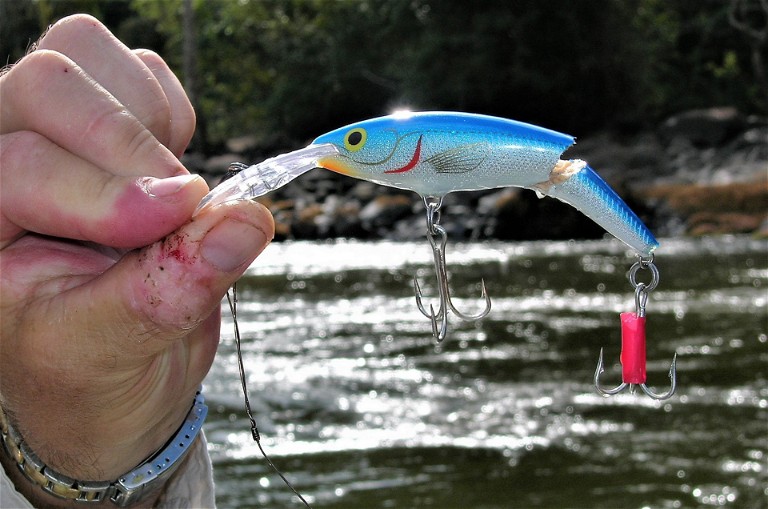
The abachi wood Rapala used in their classic range was popular, but modern super-plastics and injection-moulding techniques have superseded it.
If replacing treble hooks with singles, the popular option is to use inline hooks, (such as those by Owner, Gamakatsu, Decoy, VMC, Mustad, BKK, Vanfook or Jigstar), where the eye is in the same plane as the hook point, for stable swimming and best hooking performance. Some larger bluewater lures now come standard with this type of hook.
Sometimes double ‘claw’ (twopoint) hooks, or a mix of hook types such as a single on the rear and a treble under the belly may be needed for the lure to swim properly at higher speeds. Some lures need the stabilising influence of double or treble hooks to swim well.
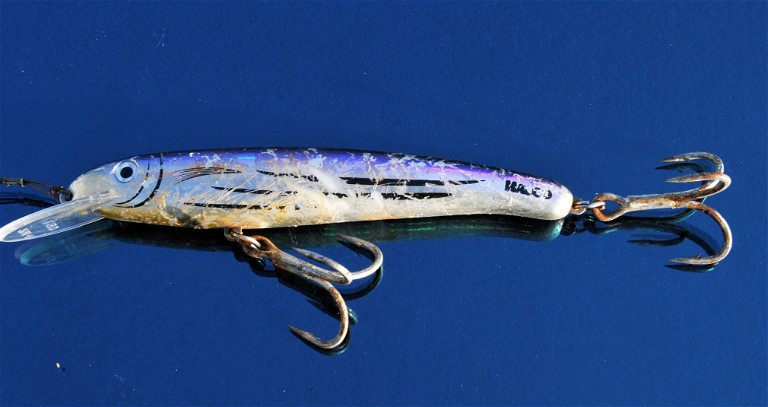
A tough plastic body and hardware upgrade has seen this Halco survive the attentions of a whole lot of toothy tropical critters.
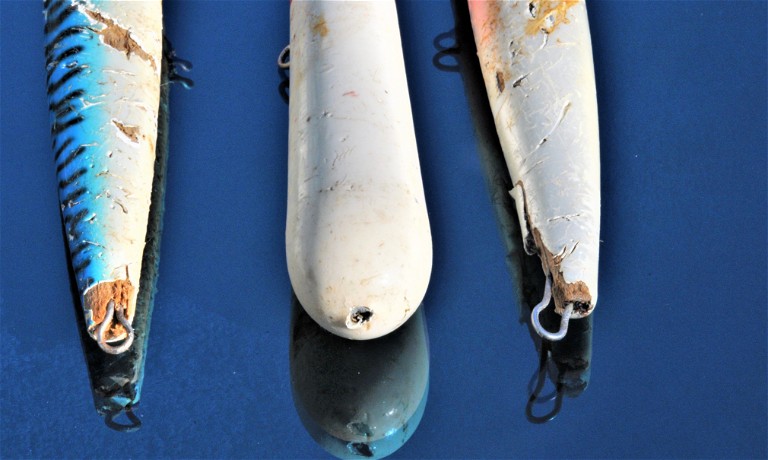
Through-body wire means that the eyelets that make up the towing point and hook attachments are strongly interconnected inside the lure body. Even if the lure is destroyed, you can still save the fish. The eyelet on the tail of the centre lure was not built this way.
One configuration that is popular is to re-rig the lure with an inline single at the tail and a larger-sized treble with flattened barbs at the belly. This rig is strong, holds well, and it is not overly difficult to unhook a fish for release.
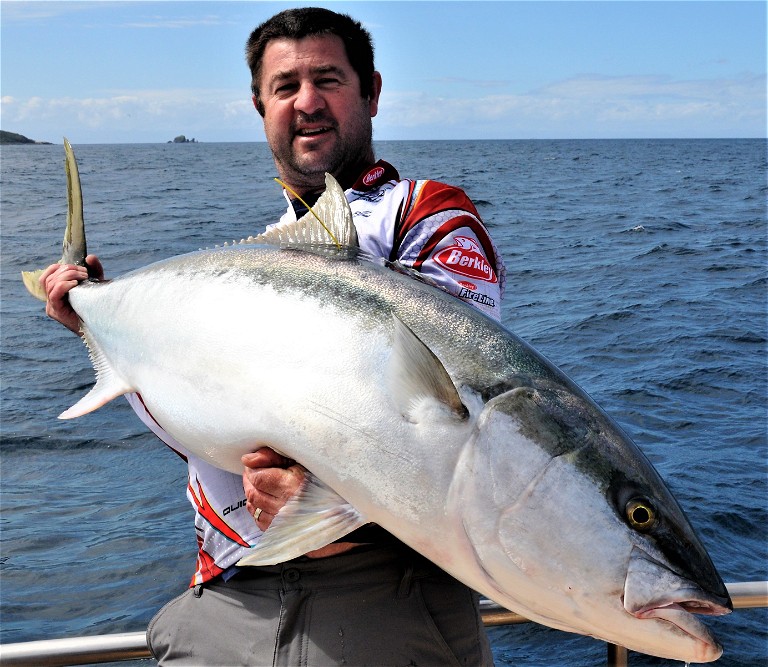
Braid and big fish add up to a lot of pressure on terminal tackle.
Hanging on
Strength is one thing, holding power is another. There is no point in having a beefed-up lure that can take the pressure exerted by, say, a 24kg, 37kg (PE 5 or 8) rig if all that pressure does is pull the hooks out of the fish. This is another good reason for changing out trebles for single hooks: with twice the gape and wire thickness of a treble, a single hook is much less likely to ‘pull’.
But some lures, as just mentioned, require treble hooks to balance them and allow them to swim well. So, if replacing trebles with stronger trebles, it is a good move to go up one or two sizes so the hook has a wider ‘bite’ and is less likely to pull when asked the question with heavy tackle and big fish. Super-strong treble hooks include those from Gamakatsu, Owner, Decoy and the BKK Raptor.
If lures, such as poppers, stickbaits or minnows are armed with two sets of trebles and lure balance is not an issue, removing the belly trebles will help ease the problems when unhooking fish. Flattening the barbs is another approach.
One configuration that is popular is to re-rig the lure with an inline single at the tail and a larger-sized treble with flattened barbs at the belly. This rig is strong, holds well, and it is not overly difficult to unhook a fish for release. A belly treble can also be replaced with back-to-back singles; a cable tie is often used to keep the shanks in place.
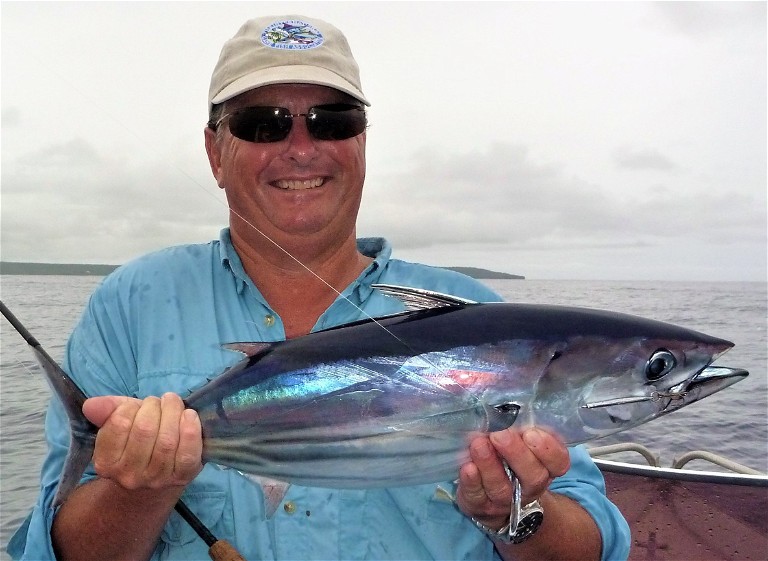
The principles of toughening up terminal tackle to cope with the pressures exerted by modern braid lines apply all the way down to tiny lures and light rod and reel combos used on snapper, kahawai, skipjack, and the like.
The action attraction
Lures with an action, either inbuilt or imparted by the angler, need to be able to move freely on the end of the line for best attraction to fish. This can be allowed for by tying a fixed loop knot like a perfection loop or Lefty’s loop at the tow point but a thing to watch for is chafing of the loop knot at the tow point over time. Knots like a uni knot or improved clinch seize down tight on the tow point and can avoid most chafing but can choke down the action of the lure unless an extra ring is attached to the tow-point eyelet and the line tied to that. Some lures (Halco and Rapala are examples) incorporate this extra ring when they make the lure, but a split ring can be added – just be sure it is high quality and really strong.
A variation is a strong swivel tied (or crimped) semi-permanently to the end of the leader with an equally strong split ring attached. This has the added advantage of allowing changing lures (using split ring pliers) without re-doing knots or crimps and consequently chipping away at your leader length. It helps keep twist out of the line, too. This system works best with larger lures, the action of which are not greatly affected by the extra weight of the swivel and split ring on the nose.
The trick when upgrading the hardware on topwater lures or minnows is not to overpower a lure and kill its action (and attractiveness to fish) by fitting it with hooks that are too large or heavy for the lure’s swimming action to sustain. As mentioned, too-large or heavy hooks will sandbag the lure’s action, while over-sized split rings can bind up in the eye of the lure and/or the hook. Over-thick hooks can prove hard to set with light tackle, too. Upgrading hardware must be done carefully and to this end, I always have an eye out for suitable hooks, trebles and split rings when visiting tackle stores or shopping online.
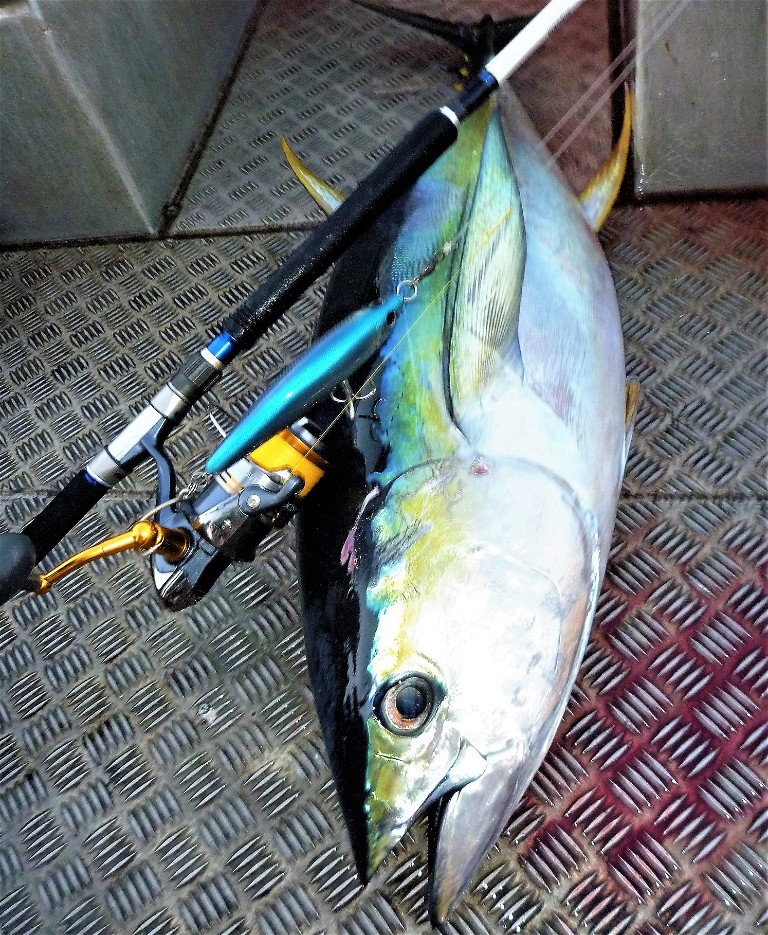
A stick bait re-rigged with an inline tail hook and up-graded belly treble produced a nice yellowfin for Sam after an hour-long fight on PE 5 braid.